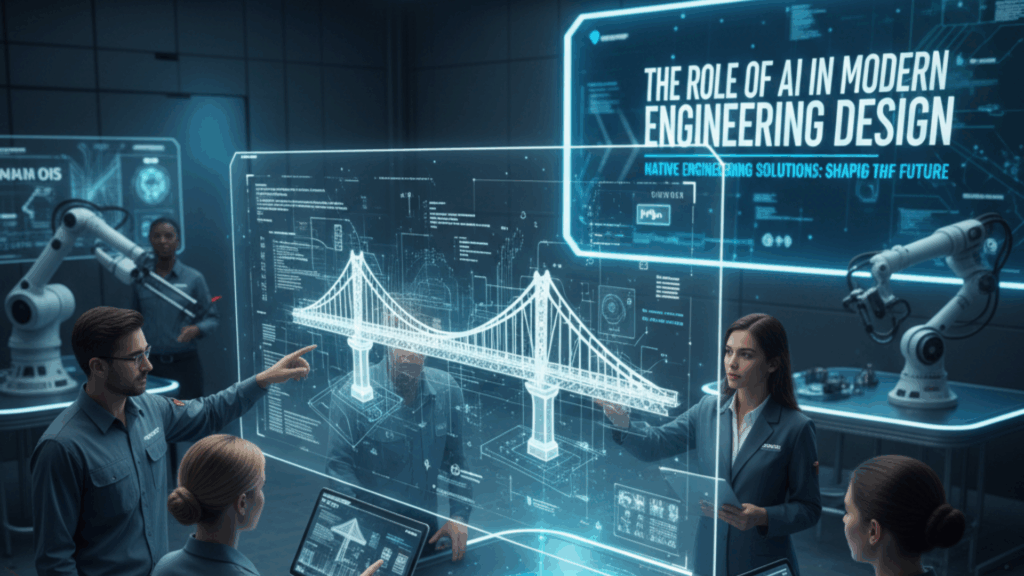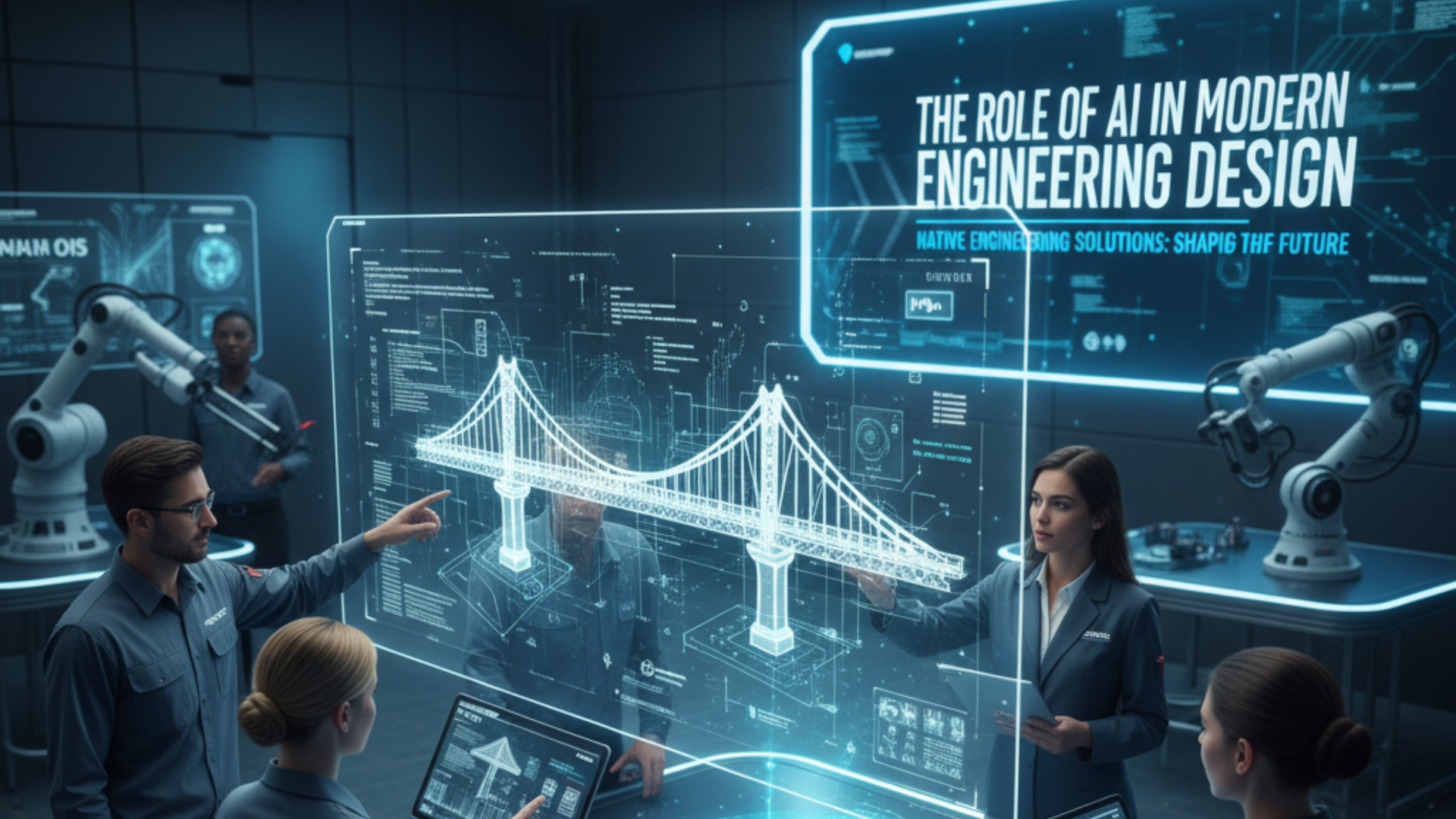The Role of AI in Modern Engineering Design: How Native Engineering Solutions is Shaping the Future
In the past decade, the boundaries between engineering and digital technology have blurred. From bridges that “think” to machines that “learn,” the world of engineering design is entering a new era — one powered by Artificial Intelligence (AI).
At Native Engineering Solutions, we’re not just adapting to this change — we’re driving it. By integrating AI into our design processes, we’re reimagining how engineering challenges are solved, how innovation is accelerated, and how sustainability is achieved.
1. The Changing Landscape of Engineering Design
Traditional engineering design has long been a blend of expertise, equations, and experience. Engineers used CAD models, simulations, and human judgment to develop solutions that met performance, safety, and cost requirements.
But as systems have grown more complex — from electric vehicles to smart infrastructure — traditional tools alone can’t keep up with the speed, precision, and adaptability required today. That’s where AI comes in.
Artificial Intelligence transforms engineering design from a linear, manual process into a dynamic, data-driven ecosystem. It empowers engineers to explore thousands of design possibilities, predict outcomes with incredible accuracy, and make smarter decisions faster.
At Native Engineering Solutions, we view AI not as a replacement for human creativity, but as a powerful partner that amplifies it.
2. How AI Is Transforming the Engineering Design Process
a. Generative Design: From Concepts to Innovation
One of the most exciting applications of AI in engineering is generative design. Using algorithms inspired by nature, AI systems can generate thousands of design alternatives based on constraints like material type, manufacturing methods, weight, and cost.
Imagine telling a computer the problem — and having it deliver optimized solutions that even seasoned engineers might never consider.
At Native Engineering Solutions, we use AI-driven generative design tools to help clients uncover the most efficient, sustainable, and cost-effective designs possible. This not only reduces development time but also sparks innovation that traditional design approaches might miss.
b. Smart Simulation and Optimization
AI is enhancing simulation processes by predicting how a design will perform under real-world conditions — without the need for exhaustive testing.
For example, machine learning models can detect stress points in a mechanical structure or predict thermal inefficiencies in electrical systems before a single prototype is built.
Our engineers at Native Engineering Solutions use AI-powered simulations to fine-tune designs early in the process, helping clients save on materials, testing costs, and time.
c. Automation: Efficiency at Every Stage
Every engineering project involves repetitive yet essential tasks — from geometry corrections to data validation. AI automation eliminates these bottlenecks, allowing engineers to focus on creativity and problem-solving.
By automating tasks like CAD updates, data entry, and report generation, Native Engineering Solutions delivers projects faster, with greater consistency and fewer human errors. The result is higher efficiency and better value for every client.
d. Predictive Analytics and Maintenance
AI doesn’t stop at design — it also extends into operation and maintenance. Predictive analytics uses real-time data from sensors and equipment to forecast potential failures and optimize maintenance schedules.
For industries like manufacturing, construction, and energy, this means reduced downtime, longer asset life, and improved safety.
At Native Engineering Solutions, we integrate AI-powered predictive models into our engineering systems to ensure continuous performance improvement and proactive maintenance planning.
3. AI Across Engineering Disciplines
AI is not confined to one branch of engineering — it’s transforming them all. Here’s how Native Engineering Solutions is applying AI across key disciplines:
Mechanical Engineering: Generative design tools help us create lightweight, strong components for automotive, aerospace, and industrial applications.
Civil & Structural Engineering: AI assists in optimizing materials, construction methods, and safety analysis for smarter, more resilient infrastructure.
Electrical Engineering: Machine learning enhances circuit optimization, power distribution, and energy management systems.
Industrial & Process Engineering: Data-driven insights help streamline production workflows, improve quality control, and reduce waste.
No matter the field, AI allows our team to design smarter, build faster, and deliver better.

4. The Benefits of an AI-Driven Engineering Approach
The integration of AI into modern design isn’t just about technology — it’s about results.
Here’s what our clients gain from Native Engineering Solutions’ AI-enhanced design process:
🚀 Faster Project Delivery: Reduced design cycles mean you move from concept to completion in record time.
🎯 Greater Accuracy: Predictive algorithms minimize errors and improve simulation reliability.
💡 Innovation at Scale: Explore more design possibilities and achieve performance breakthroughs.
🌱 Sustainability: Optimize materials and energy use to reduce environmental impact.
💰 Cost Efficiency: Fewer physical prototypes and optimized resources lead to significant savings.
By combining human ingenuity with machine intelligence, we ensure every project is smarter, safer, and more sustainable.
5. Challenges and Responsible AI Integration
While the benefits of AI are vast, responsible integration is crucial. Engineering is about trust — and AI must enhance that trust, not undermine it.
At Native Engineering Solutions, we approach AI with transparency, ethics, and accountability.
We ensure that:
Data used to train our models is accurate, unbiased, and secure.
Engineers remain in control of final design decisions.
AI tools are used to support, not replace, human expertise.
Our team stays at the cutting edge through continuous training and professional development.
By adopting these principles, we build solutions that are not only technologically advanced but also ethically grounded.
6. The Future of Engineering Design with AI
The future of engineering design is not just digital — it’s intelligent. As AI technologies like digital twins, reinforcement learning, and real-time data modeling mature, the potential for innovation will only expand.
Imagine virtual prototypes that adapt instantly to design changes, or AI systems that learn from every project to make the next one even better.
At Native Engineering Solutions, we’re investing in these technologies today to prepare our clients for tomorrow. Whether it’s optimizing a manufacturing line, designing next-generation infrastructure, or creating sustainable energy systems, our AI-driven design philosophy ensures we stay ahead of the curve.
Conclusion: Engineering the Future, Intelligently
Artificial Intelligence is reshaping how we imagine, design, and deliver engineering solutions. But at its core, AI is a tool — one that amplifies human potential.
At Native Engineering Solutions, we believe the future of engineering lies in collaboration between human creativity and artificial intelligence. Together, they form a powerful partnership that drives innovation, sustainability, and excellence.
By combining data-driven insight with real-world expertise, we’re building the intelligent engineering solutions the world needs — today and for generations to come.

